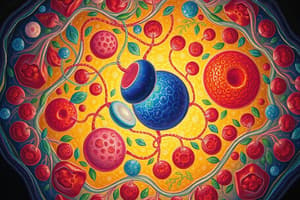Podcast
Questions and Answers
How does the cell membrane regulate what happens inside of the cell?
How does the cell membrane regulate what happens inside of the cell?
Cell growth & division
How does the SA:V ratio change as the size of the cube changes?
How does the SA:V ratio change as the size of the cube changes?
As the size of the cube decreases, the SA:V ratio increases. As the size of the cube increases, the SA:V ratio decreases.
How does the shape of the object affect the SA:V ratio?
How does the shape of the object affect the SA:V ratio?
The shape can affect the SA:V ratio depending on if it allows for a large amount of surface area and/or volume. Cubes offer better ratios than spheres.
How does the surface area to volume ratio affect diffusion time in a cell?
How does the surface area to volume ratio affect diffusion time in a cell?
Identify a cell structure that would allow for the maximum volume with the minimum diffusion time.
Identify a cell structure that would allow for the maximum volume with the minimum diffusion time.
Find an example of a prokaryote and a eukaryote that reproduce using asexual reproduction.
Find an example of a prokaryote and a eukaryote that reproduce using asexual reproduction.
What are the advantages and disadvantages of both sexual and asexual reproduction?
What are the advantages and disadvantages of both sexual and asexual reproduction?
Why is cell division considered reproduction for some organisms, but not for others?
Why is cell division considered reproduction for some organisms, but not for others?
Write instructions to build a eukaryotic chromosome.
Write instructions to build a eukaryotic chromosome.
What is a centromere?
What is a centromere?
Explain why an organized chromosome structure is an important adaptation for eukaryotic organisms.
Explain why an organized chromosome structure is an important adaptation for eukaryotic organisms.
What is binary fission?
What is binary fission?
How does cell division differ between eukaryotes and prokaryotes?
How does cell division differ between eukaryotes and prokaryotes?
Describe how a eukaryotic cell's chromosomes change as a cell prepares to divide.
Describe how a eukaryotic cell's chromosomes change as a cell prepares to divide.
What is the role of spindle fibers?
What is the role of spindle fibers?
What organelles replicate during G2?
What organelles replicate during G2?
How does plant cytokinesis differ from animal cell cytokinesis?
How does plant cytokinesis differ from animal cell cytokinesis?
How is the cell cycle regulated?
How is the cell cycle regulated?
What are the two types of proteins that regulate the cell cycle?
What are the two types of proteins that regulate the cell cycle?
Flashcards are hidden until you start studying
Study Notes
Cell Membrane Regulation
- Cell membrane controls internal cell environment influencing growth and division.
Surface Area to Volume Ratio
- As cube size decreases, surface area to volume (SA:V) ratio increases; larger cubes result in a decreased SA:V ratio.
- Shape impacts SA:V ratio; cubes provide better ratios than spheres.
Diffusion Time and SA:V Ratio
- Smaller SA:V ratios lead to longer diffusion times; larger ratios result in shorter diffusion times.
Optimal Cell Structure for Volume and Diffusion
- Mitochondria maximize volume while minimizing diffusion time.
Asexual Reproduction Examples
- Prokaryote example: Bacteria
- Eukaryote example: Protists
Reproduction Advantages and Disadvantages
- Sexual reproduction: advantages include genetic variation and mate selection; disadvantages involve energy costs and time.
- Asexual reproduction: advantages include rapid reproduction without a mate; disadvantage lacks genetic variation.
Cell Division as Reproduction
- For some organisms, cell division leads to mere cell replication, while in others, it results in the generation of entirely new organisms.
Building a Eukaryotic Chromosome
- DNA strand coils, wraps around histone proteins, forming a supercoil, which further coils to create the chromosome structure.
Centromere Function
- The centromere is the chromosome's central region where sister chromatids connect.
Importance of Organized Chromosome Structure
- Organized chromosome structures enable efficient processes, ensure proper genetic material distribution, and confine DNA within a limited space.
Binary Fission Process
- DNA duplicates, membrane indents, and divides, forming two new cellular entities.
Differences in Cell Division
- Eukaryotic cells utilize spindles and centromeres during division; prokaryotic division is faster and does not condense nuclear material.
Chromosome Changes During Division
- Chromosomes attach to spindle fibers, condense, and become visible as the cell prepares to divide.
Role of Spindle Fibers
- Spindle fibers align and separate chromosomes during mitosis.
Organelles Replicating in G2 Phase
- Organelle replication in G2 involves the nucleus, mitochondria, and chloroplasts, all containing DNA.
Cytokinesis in Plant vs Animal Cells
- In animals, cytokinesis divides cytoplasm forming daughter cells; in plants, a cell plate develops into the cell membrane.
Regulation of the Cell Cycle
- Cell growth occurs until contact with other cells; cyclins regulate the timing of the cell cycle.
Types of Cell Cycle Regulators
- Internal proteins respond to internal cell events like checkpoints.
- External proteins react to external events, influencing the speed of the cell cycle.
Studying That Suits You
Use AI to generate personalized quizzes and flashcards to suit your learning preferences.




